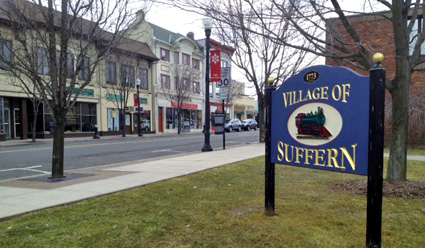People, places, things. Suffern is a cornerstone to a healthy Ramapo Valley and helps anchor western Rockland County — along with the circle that is Sloatsburg (and Hillburn). The Village of Suffern appears to have weathered the down draft of the last few budget-tightening years.
The Shamrock Hotel at the Franklin Tpke/Rt. 202 junction is thriving. Cross fingers, but it sure looks that way. Visit for a draught. Handy Hardware in the Hines Play House building has been serving customers since the turn of the century, near 90 years now. And a 30,000 square foot Rainbow Ace is scheduled to invest a pot of gold in the village.
 The Clifford Theater and village recreation. Easter Egg hunts. Parades and civic celebrations. Village services. The Department of Public Works and road repair. Chief Clark Osborne and the Suffern Police Department. Infrastructure investment. Business development. The library. Schools. All are interlocking services and activities that make a dent in villagers’ pocket books.
The Clifford Theater and village recreation. Easter Egg hunts. Parades and civic celebrations. Village services. The Department of Public Works and road repair. Chief Clark Osborne and the Suffern Police Department. Infrastructure investment. Business development. The library. Schools. All are interlocking services and activities that make a dent in villagers’ pocket books.
Suffern Mayor Dagan Lacorte and the Village Board announced Wednesday the state of Suffern as it prepares its 2013-1014 village budget.
With a total proposed budget of $11.9 million, Suffern will raise $8.9 million from property taxes, keeping the increase at 1.85%, which falls under the NY state local control Tax Cap. Suffern property taxes will increase 2.3% overall due to a decline in property values. Other avenues of village revenues come from permits and contracted fees.
Taxpayers can expect to pay $6.08 per $100 of assessed value on their property, up from $5.94 per $100 this year.
 This is the second straight year Mayor Lacorte and the village have kept the village budget under the state cap mandate. Suffern has shed about eight village positions over the last few years, which translates into nearly $700,000 in savings. Other reductions include savings on the Suffern water and sewer funds. The village currently carries $800,000 in debt service.
This is the second straight year Mayor Lacorte and the village have kept the village budget under the state cap mandate. Suffern has shed about eight village positions over the last few years, which translates into nearly $700,000 in savings. Other reductions include savings on the Suffern water and sewer funds. The village currently carries $800,000 in debt service.
Rockland County has nineteen other villages scattered across five towns (with some twenty hamlets thrown in). All go through similar budget processes, allocating resources, issuing of debt, and providing community services. Lacorte is currently a candidate for Rockland County Executive and is touting Suffern’s infrastructure improvements during his tenure and debt service management, along with budgeting to the state cap, as significant features of his candidacy.
Recent Suffern improvements include $1.4 million toward roadways, $1.3 million in sewer plant upgrades, and water plant and tower and DPW facility upgrades. The village plans to invest an additional $2.1 million in water, sewer and road upgrades during 2013.
As a full service village, Suffern’s budget and civic issues mirror some of the county’s line items, such as a law enforcement department and public works, which involves roads and water and sewer management at the local level — all high points Lacorte emphasized in Suffern’s budget process. But Rockland County features a sprawling 32 departments, with some of the most visible being Sheriff, District Attorney, highways, public transportation, and education. Plus state and federal dollars often go through the county as they make their ways into towns and villages.
Local residents will sling stones first at their own elected officials if services decline in quality or taxes increase a pinch.
Village governments feel the wrath of residents not only when taxes increase, but when local neighborly services are cut. Factor in the Ramapo Central School Budget and Suffern Free Library budget vote (which takes place March 20), a proposed Town of Ramapo 9% proposed tax hike and an additional 18 percent hike currently on the table for Rockland County, and it’s understandable why good municipal budget numbers are important.
The Suffern village board meets for more budget workshopping and public hearing on the proposal Wednesday, March 27, and is scheduled to vote on it’s budget April 1.


